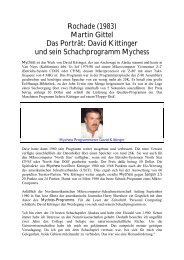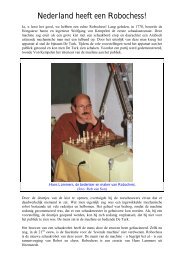10-1984 [C-8401] Fidelity - Chess Challenger Elegance (second ...
10-1984 [C-8401] Fidelity - Chess Challenger Elegance (second ...
10-1984 [C-8401] Fidelity - Chess Challenger Elegance (second ...
You also want an ePaper? Increase the reach of your titles
YUMPU automatically turns print PDFs into web optimized ePapers that Google loves.
<strong>10</strong>-<strong>1984</strong> [C-<strong>8401</strong>] <strong>Fidelity</strong> - <strong>Chess</strong> <strong>Challenger</strong> <strong>Elegance</strong> (<strong>second</strong> edition)<br />
Model 6085 of ook wel als AS12 op de markt verschenen. Vlak na het microwereldkampioenschap<br />
in Glasgow kwam de <strong>Elegance</strong> op de markt. Een handzaam ARB-model natuurlijk<br />
voorzien met het Glasgow programma. De eerste 50 exemplaren van de <strong>Elegance</strong> werden<br />
geproduceerd met een 3 MHz CPU (zie daarover mijn andere item). Daarna verscheen het<br />
2 e standaard model met 3,6 MHz. Later verschenen er (niet originele) opgevoerde versies met<br />
5,0 MHz. of meer. In een kleine brochure van <strong>Fidelity</strong> uit 1985, las ik dat de <strong>Elegance</strong> een<br />
programma heeft van 20 KB Rom. Andere bronnen spreken van 24 KB Rom. Altijd nog 4 KB<br />
Rom minder dan zijn grote broer, de Elite A/S. Zelf houd ik het op 24 KB Rom.<br />
<strong>Fidelity</strong> <strong>Elegance</strong> (Info Herbst <strong>1984</strong>)<br />
Der <strong>Elegance</strong> <strong>Challenger</strong>, Nachfolgeprogramm des Elite S, hat auf der 4. Microcomputer-<br />
Weltmeisterschaft <strong>1984</strong> in Glasgow, zwei Partien in Gewinnstellung durch technischen<br />
Defekt bzw Zeitüberschreitung verloren. Keine Verlustpartie durch schlechteres Spielen! Ein<br />
Remis gegen Conchess, Sieg gegen Mephisto Exclusive S! Spielerisch machte er den<br />
stärksten Eindruck auf der WM. Er besteht aus einem eleganten Holzbrett mit<br />
selbstreagierenden Reed-Kontakten. Im Aussehen entspricht er genau dem Elite S in kleinerer<br />
Version. Display, Uhr und Stimme wurden aus Kostengrunden eingespart.<br />
In Montreal gewann der <strong>Elegance</strong> (Exp.) mit 5:0 gegen 3 Groβrechner!<br />
1. <strong>Elegance</strong> (Experimental) 5:0<br />
2. Phoenix 4:1<br />
3. Super Constellation (Experimental) 3:2<br />
4. Awitt 2:3<br />
5. Ostrich 1:4<br />
6. Levy (CXG 2001) 0:5<br />
Der <strong>Elegance</strong> hat einen 24 KByte Speicher, das Programm läuft auf EPROMs, die später<br />
leicht auszuwechseln sind, zB. für hitzebeständigere, die eine Erhöhung der Taktfrequenz von<br />
jetzt 3 auf 6 MHz. und mehr möglich machen. Dieses “Speed up kits” ist Zukunftsmusik und<br />
dauert rnindestens noch ½ Jahr. Die Eröffnungsbibliothek umfaβt 3000 Stellungen. Ein<br />
Einschubfach für ein zusätzliches Eröffnungsmodul ist wie beim Elite S vorhanden.<br />
Seine Partien zeigen eine hervorragende Spielstärke, vor allem auch im Endspiel. Er wird<br />
Ende Okt. 84 in zwei Versionen auf den Markt kommen.<br />
Einmal mit 3,6 MHz. zu ca. DM 1.<strong>10</strong>0,00 und mit 5 MHz. zu DM 1.250,00.
<strong>Elegance</strong> <strong>Chess</strong> <strong>Challenger</strong> …<br />
• Hand-crafted nutwood housing with inlaid top. <strong>10</strong>0% solid state. Hand-carved Staunton<br />
wood chess pieces. Internal clock keeps track of time control (accuracy ± 5%).<br />
• Twelve different levels of play.<br />
Levels 1-8 automatically adjust computer’s thinking time<br />
for 5 minute games to games lasting several hours.<br />
Level 9 is infinite, user activated.<br />
Level <strong>10</strong>: mate in two.<br />
Level 11: mate in three.<br />
Level 12: mate in four.<br />
• Special easy mode weakens all skill levels (1-8) without changing time controls.<br />
• Thinks on the opponent’s time for faster response and stronger play.<br />
• Book openings selectable over 3,000 positions. Cycle through book opening<br />
choices for the computer or the player at the touch of a single button.<br />
• Book practice mode. Learn established book openings. Electronic practice teaches<br />
quickly, because game will signal a warning if move played is not in book.<br />
• Take-back feature allows you to take back moves right to the beginning of the game.<br />
Replay a move series asking computer to indicate its suggested move<br />
during that move series to see where you may have erred in judgement.<br />
• Change skill level at anytime on your move.<br />
• Change sides at anytime on your move. You can always be a winner.<br />
• Draws and stalemates. Indicates draws in three separate categories and<br />
signals which type applies: stalemate, 50-move rule, opponent’s or<br />
computer’s move or position repeated three times.<br />
• Player mode for regular 2-player games, the computer referees<br />
legal moves, draws and can even recommend a move when asked.<br />
• While thinking, computer can display the moves it is considering making.<br />
• Can suggest a move for you to make and indicate the continuing line of play.<br />
• Large <strong>10</strong> x <strong>10</strong> auto-sensory inlaid wood playing surface,<br />
consisting of switches actuated by magnets in the bases of chess pieces.<br />
• 64 Light Emitting Diodes (LED) indicate moves.<br />
• Printer outlet, a permanent record of your most interesting games<br />
and special positions, may be obtained by using optional <strong>Fidelity</strong> printer.<br />
• Built-in rechargeable condensor saves memory of game for up to one hour in the event of<br />
accidental power shutdown.<br />
• Cartridge capability:<br />
- CB-9 Module<br />
- CB-16 Module<br />
- Tarrasch Defense module<br />
- 64 Greatest Games module<br />
- ECO modules (A thru E)<br />
• AC adaptor.
ELEGANCE<br />
The first <strong>Fidelity</strong> computer containing the all new Glascow or "C" program, the <strong>Elegance</strong>,<br />
combines beautiful styling with the latest improvements from last year's strongest program,<br />
the Budapest World Champion or "B" program. This new program is between 50-<strong>10</strong>0 points<br />
better than the EAS-B [Elite A/S Budapest World Champion], and is certainly one of the top<br />
chess computers along with the Super Constellation and Elite A/S-C (4.0) [Elite A/S Glasgow<br />
World Champion with 4,0 MHz]. Several features have been removed to reduce the cost and<br />
make the <strong>Elegance</strong> a very attractive offer to those looking for a highly advanced chess<br />
computer for an economical price. Most of the features that were left out, were frivolous and<br />
would only have added an extra expense to the unit. The voice was one, and the built in<br />
display (important only if you must have a chess clock) was another.<br />
Upon examining the <strong>Elegance</strong>, the first thing 1 noticed were the extra steps required to start<br />
up the unit. Apparently, this procedure is necessary to eliminate any operating problems. The<br />
playing surface is larger than standard sets with a <strong>10</strong> x <strong>10</strong>" playing area and 1¼" squares.<br />
Another advantage the <strong>Elegance</strong> has over other computers in its price range is an auto<br />
response board with LED's on every square. Strong contacts had to be used for an autoresponse<br />
board this small, so extra small magnets have been placed on each piece. The only<br />
problem with this is that the magnets are just glued on the bottom of each piece with no felt<br />
covering to prevent the magnets from scratching the wood surface. Besides being an eyesore,<br />
the magnets are too large for the size of the pieces. And to make matters worse, you can not<br />
substitute your own pieces unless you can get industrial strength magnets.<br />
Despite these inconveniences , the <strong>Elegance</strong> lives up to its name in every respect. Although<br />
not exhaustively tested yet, the <strong>Elegance</strong> has displayed a remarkable sense of strategic<br />
knowledge in its test games against computer and human competition. Tactically, <strong>Elegance</strong> is<br />
usually a bit more accurate than the Super Constellation in the long run, but more predictable<br />
by playing less risky. A realistic comparison is made difficult by the overuse of sacrificial<br />
themes by Super Constellation which tends to cause distortions, even in positions where any<br />
sacrificing is unsound. <strong>Elegance</strong> will not sacrifice without a sound basis for doing so, leading<br />
to a slightly more mundane game than the Super Constellation, but its overall sounder style<br />
will frustrate anyone who takes it lightly.<br />
Some of the features on the <strong>Elegance</strong> make it easier for tournament players to analyze games<br />
or variations than it would to perform these tasks on other computers. For example, the book<br />
practice mode allows unlimited study of opening systems without having to restart the game.<br />
Although I do object to the high priority given to the ridiculous opening move 1. b4, which it<br />
plays as frequently as it does normal openings such as 1. e4, 1. d4, etc. Not only is 1. b4 rarely<br />
played by humans, it is also considered weaker than more conventional openings. To show<br />
alternate moves in any position, <strong>Elegance</strong> will show a predicted variation for up to four full<br />
moves. The only serious drawback here is that the built-in opening book is much too small for<br />
experienced players. Possibly, <strong>Fidelity</strong> is giving people an incentive to buy one of their<br />
opening book modules.<br />
Even without an extensive array of openings, <strong>Elegance</strong> is a most enjoyable machine on any<br />
level, from speed chess to postal chess. This is one great chess computer with which you can<br />
not go wrong.<br />
Source: Computer <strong>Chess</strong> Digest Supplement 1985 Vol. 3<br />
___________________________________________________________________________
<strong>Elegance</strong> <strong>Challenger</strong> in Stichpunkten<br />
• Modell: 6085 / AS12<br />
• Gehäuse: ca. 36 x 36 x 4,5 cm<br />
• Spielfläche: 26,5 x 26,5 cm<br />
• Druckeranschluβ: ja<br />
• Programm: erweiterbar<br />
• Stellungsspeicher: ja<br />
• Feldkennzeichnung: 64 LEDs<br />
• Schachuhr: wird nur durch den Drucker ausgegeben<br />
• Zugzähler: wird nur durch den Drucker ausgegeben<br />
• Spielstufen: 8<br />
• Matt/Analysestufen: 4<br />
• Zugzurücknahme: beliebig<br />
• Partiewiederholung: wird nur durch den Drucker ausgegeben<br />
• Blick in Rechenvorgang: eingeschränkt möglich<br />
• Mattankündigung: ja<br />
• Aufgabe der Partie: ja<br />
• Remisregeln: ja<br />
• Eröffnungsrepertoir von 3000 Halbzügen (erweiterbar)<br />
• Mattführung mit: Zwei Läufern<br />
• Opposition von König gegen König + Bauer in Turnierstufe: ja<br />
• Unterverwandlungen in Turm, Läufer oder Springer: ja<br />
___________________________________________________________________________<br />
Programmierer / Programmer<br />
• Dan & Kathe Spracklen<br />
Baujahr / Release<br />
• Erste Einführung (mit 3,6 MHz): Oktober <strong>1984</strong><br />
Technische Daten / Technical specifications<br />
• Mikroprozessor: 6502<br />
• Taktfrequenz: 3,6 MHz<br />
• Programmspeicher: 24 KB ROM<br />
• Arbeitsspeicher: 4 KB RAM<br />
Spielstärke / Playing strength<br />
• Spielstärke: ca. 1750<br />
___________________________________________________________________________
Literaturhinweise / References / Literatuuroverzicht<br />
• 03-<strong>1984</strong>, Europa-Rochade, S.15, Hans-Peter ketterling: Nürnberger Allerlei - ein<br />
Messebericht.<br />
• 06-<strong>1984</strong>, Zeitschrift Schachcomputer (Herausgeber Florian Piel), Edition 12, S.6-8,<br />
Palette der Schachcomputer Jahrgang <strong>1984</strong>.<br />
• <strong>10</strong>-<strong>1984</strong>, CSS 4+5/84, S.7-15: Vier Weltmeister - Mikrocomputer-<br />
Schachweltmeisterschaft in Glasgow.<br />
• 12-<strong>1984</strong>, CSS 6/84, S.8-15, Hans-Peter Ketterling: Schachcomputer Weihnachten <strong>1984</strong>.<br />
Die groβe Marktübersicht.<br />
[Een korte bespreking van o.a. de <strong>Elegance</strong>. Aankoopprijs: DM 1198,00!]<br />
• 12-<strong>1984</strong>, Europa-Rochade, S. 38, Hans-Peter Ketterling:<br />
Welchen Schachcomputer zu Weihnachten?<br />
• 12-<strong>1984</strong>, DM-Verbrauchermagazine S.115-117, Hans-Peter Ketterling: Neue Modelle -<br />
Vom Weltmeister mattgesetzt.<br />
• 02-1985, Zeitschrift Schachcomputer (Herausgeber Florian Piel), Edition 16, S.8-<strong>10</strong>,<br />
Nürnberger Spielwarenmesse 1985.<br />
[<strong>Fidelity</strong> <strong>Elegance</strong> 6 MHz – nachrüstsatz.]<br />
• 03-1985, Europa-Rochade nr. 3 (März 1985), S.18, H.-P. Ketterling: Neues aus Nürnberg.<br />
H.-P. Ketterling: … Generell will man existierende Geräte in schnelleren Versionen<br />
anbieten, die Rede war dabei von CC sensory 12 sowie evtl. Elite-S, der zur Zeit<br />
bekanntlich mit 4,0 MHz ausgeliefert wird. Wann der Elite Privat die lang versprochenen<br />
5,0 MHz erreichen wird, ist auch noch nicht ganz klar. Es verdichtete sich jedenfalls der<br />
Eindruck, daβ die bei der Steigerung der Rechnertaktfrequenzen entstehenden Probleme<br />
bei <strong>Fidelity</strong> etwas unterschätzt worden sind. Trotzdem wurde erneut von Speeder-Kits<br />
gesprochen, mit denen man die Geräte nachträglich aufmöbeln können soll. Die Angaben<br />
waren jedoch vage und über Preise und Lieferzeiten war noch keine definitive Auskunft zu<br />
bekommen. Lediglich für den <strong>Elegance</strong> und den Elite scheinen die Vorstellungen etwas<br />
konkreter zu sein. Hier wurde immerhin eine Steigerung auf 6,0 MHz in Aussicht gestellt<br />
und über <strong>10</strong>,0 MHz andeutungsweise gesprochen. Das Programm des Elite-S enthält<br />
übrigens eine Macke, die bei Blitzpartien mit einer Lange von über 60 Zügen zutage tritt<br />
und bisher weitgehend unbemerkt blieb, man kann ihn dann per Zeitüberschreitung<br />
schlagen. Inzwischen ist das Programm in dieser Hinsicht jedoch bereinigt worden …<br />
• 04-1985, CSS 2/85, S. <strong>10</strong>-15, Frederic Friedel: Überwiegend heiter. Gute Stimmung und<br />
neue Produkte auf der Nürnberger Spielwarenmesse.<br />
[Wegens de stijgende Dollarkoers ging de prijs omhoog naar DM 1700,00!]<br />
• 04-1985, Zeitschrift Schachcomputer (Herausgeber Florian Piel), Edition 17, S.32,<br />
Aktuelle Nachrichten.<br />
[<strong>Fidelity</strong> <strong>Elegance</strong>, afgerond: 3,68 MHz.]<br />
• 05-1985, Kijk, Max Pam: Kijk test twaalf schaakcomputers.<br />
[De volgende schaakcomputers werden besproken: <strong>Elegance</strong> <strong>Chess</strong> <strong>Challenger</strong>, Mephisto<br />
Exclusive, Super Constellation, <strong>Chess</strong> <strong>Challenger</strong> 9, Conchess, <strong>Chess</strong> 2001,<br />
Superstar 28K, Multitech CC-009, Enterprise ‘S’, Multitech CC-006, <strong>Chess</strong> Companien II,<br />
Galaxy Mark 2, Explorer en Advanced Portachess.]<br />
• ??-1985, Computer <strong>Chess</strong> Digest Supplement 1985 Vol. 3.<br />
• 09-1986, Modul 3/1986 S.43: ELO-Zahlen für Computer.<br />
[<strong>Elegance</strong> 3,6 Mhz, Conchess Glasgow 4 Mhz, Excellence 3 Mhz.]<br />
___________________________________________________________________________<br />
Last Updated on February 25, 2009


![10-1984 [C-8401] Fidelity - Chess Challenger Elegance (second ...](https://img.yumpu.com/39862288/1/500x640/10-1984-c-8401-fidelity-chess-challenger-elegance-second-.jpg)
![01-1981 [E-4551] Applied Concepts - Morphy Encore Na het ...](https://img.yumpu.com/51220743/1/184x260/01-1981-e-4551-applied-concepts-morphy-encore-na-het-.jpg?quality=85)
![10-1987 [H-1501] VEB Mikroelektronik Erfurt - Chess-Master Diamond](https://img.yumpu.com/51155071/1/184x260/10-1987-h-1501-veb-mikroelektronik-erfurt-chess-master-diamond.jpg?quality=85)
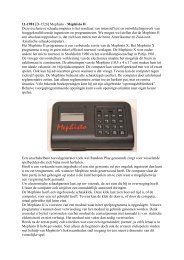
![04-1984 [L-1701] Novag - Presto Novag Art. No. 8210. Een compact ...](https://img.yumpu.com/50703692/1/184x260/04-1984-l-1701-novag-presto-novag-art-no-8210-een-compact-.jpg?quality=85)
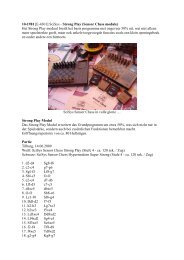
![11-1982 [E-4151] Fidelity - Voice Bridge Challenger III Fidelity ...](https://img.yumpu.com/50359671/1/184x260/11-1982-e-4151-fidelity-voice-bridge-challenger-iii-fidelity-.jpg?quality=85)
![09-1980 [E-3901] Fidelity - Challenger Printer Model: FP. Een zeer ...](https://img.yumpu.com/50108260/1/184x260/09-1980-e-3901-fidelity-challenger-printer-model-fp-een-zeer-.jpg?quality=85)

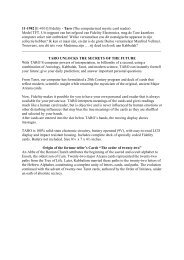
![08-1983 [G-1001] Milton Bradley - Schaakcomputers en ...](https://img.yumpu.com/49507203/1/184x260/08-1983-g-1001-milton-bradley-schaakcomputers-en-.jpg?quality=85)
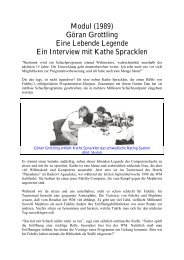
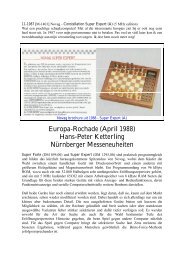
![10-1981 [E-4351] SciSys - Strong Play Plus (Sensor Chess module ...](https://img.yumpu.com/49350295/1/184x260/10-1981-e-4351-scisys-strong-play-plus-sensor-chess-module-.jpg?quality=85)
